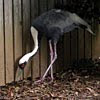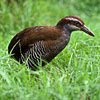 White-naped Crane
White-naped CraneRange: eastcentral Eurasia (Siberia, China)
Habitat: swamps, marshes, lakes, especially along river valleys
 Guam Rail
Guam RailGuam rails are a small flightless bird that lived only on the island of Guam in the Mariana Archipelago in the Pacific. They are omnivorous, which means they eat leaves, seeds, fruits, small lizards, bird eggs, small mammals, and carrion.
Range: Guam and nearby Rota
Habitat: various
 Black Crake
Black CrakeRange: Sub-saharan Africa
Habitat: freshwater wetlands
 Sunbittern
SunbitternRange: Central America through Brazil
Habitat: wooded swamps, humid forest along streams
 Red-legged Seriema
Red-legged SeriemaRange: lowlands of southeastern South America (Brazil, Paraguay, Bolivia, Uruguay, Argentina)
Habitat: shrubby plains
 Kori Bustard
Kori BustardDuring the breeding season, males perform “balloon” displays to attract females.
Displays can occur throughout the day, but are usually most intense in the early morning and late afternoon/evening.
During the height of the male display, the esophagus inflates to as much as four times its normal size and resembles a balloon. This display may be seen up to one kilometer (.62 miles) away. With the neck expanded, the tail and wing feathers pointed downward, and the crest erected, the male emits a low-pitched booming noise as he snaps his bill open and shut.
Range:
The nominate subspecies A. k. kori occurs in Botswana, Zimbabwe, Namibia, southern Angola, South Africa and Mozambique (Johnsgard 1991), and prefers wooded grassland areas and dry savannas. In arid grassland areas it is found along dry watercourses where patches of trees offer shade during the heat of the day. In eastern Africa, A. k. struthiunculus occurs in Ethiopia, Uganda, Sudan, Kenya and Tanzania in areas of open grasslands including karoo, bushveld, thornveld, scrubland and savanna habitats (del Hoyo 1996). The miombo woodland of Central Africa separates the two populations.
Habitat: grasslands and lightly wooded savannas of southern and eastern Africa
 Nicobar Pigeon
Nicobar PigeonRange: Southeast Asia, Malay archipelago, New Guinea region
Habitat: bushes, thick forest, mangroves
 Sulawesi Ground Dove
Sulawesi Ground DoveRange: Sulawesi (an island of Indonesia)
Habitat: dense humid forest
 Western Crowned-Pigeon
Western Crowned-PigeonRange: Island of New Guinea
Habitat: forest
 Pheasant Pigeon
Pheasant PigeonRange: New Guinea region
Habitat: forest




No comments:
Post a Comment